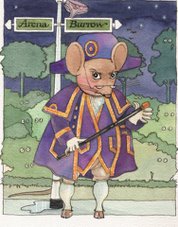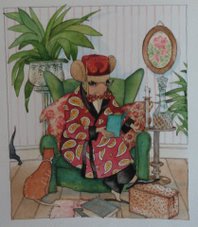From: W. H. HUDSON: "Far Away and Long Ago"
In those days, and indeed down to the seventies of last century, the south side of the capital was the site of the famous Saladero, or killing-grounds, where the fat cattle, horses and sheep brought in from all over the country were slaughtered every day, some to supply the town with beef and mutton and to make charque, or sun-dried beef, for exportation to Brazil, where it was used to feed the slaves, but the greater number of the animals, including all the horses, were killed solely for their hides and tallow. The grounds covered a space of three or four square miles, where there were cattle enclosures made of upright posts placed close together, and some low buildings scattered about To this spot were driven endless flocks of sheep, half or wholly wild horses and dangerous-looking, long-horned cattle in herds of a hundred or so to a thousand, each moving in its cloud of dust, with noise of bellowings and bleatings and furious shouting of the drovers as they galloped up and down, urging the doomed animals on. When the beasts arrived in too great numbers to be dealt with in the buildings, you could see hundreds of cattle being killed in the open all over the grounds in the old barbarous way the gauchos use, every animal being first lassoed, then hamstrung, then its throat cut - a hideous and horrible spectacle, with a suitable accompaniment of sounds in the wild shouts of the slaughterers and the awful bellowings of the tortured beasts. Just where the animal was knocked down and killed, it was stripped of its hide and the carcass cut up, a portion of the flesh and the fat being removed and all the rest left on the ground to be devoured by the pariah dogs, the carrion hawks, and a multitude of screaming black-headed gulls always in attendance. The blood so abundantly shed from day to day, mixing with the dust, had formed a crust half a foot thick all over the open space: let the reader try to imagine the smell of this crust and of tons of offal and flesh and bones lying everywhere in heaps. But no, it cannot be imagined. The most dreadful scenes, the worst in Dante's Inferno, for example, can be visualized by the inner eye; and sounds, too, are conveyed to us in a description so that they can be heard mentally; but it is not so with smells. The reader can only take my word for it that this smell was probably the worst ever known on the earth, unless he accepts as true the story of Tobit and the "fishy fumes" by means of which that ancient hero defended himself in his retreat from the pursuing devil.
It was the smell of carrion, of putrifying flesh, and of that old and ever-newly moistened crust of dust and coagulated blood. It was, or seemed, a curiously substantial and stationary smell; travellers approaching or leaving the capital by the great south road, which skirted the killing-grounds, would hold their noses and ride a mile or so at a furious gallop until they got out of the abominable stench.
One extraordinary feature of the private quintas or orchards and plantations in the vicinity of the Saladeros was the walls or hedges. These were built entirely of cows' skulls, seven, eight, or nine deep, placed evenly like stones, the horns projecting. Hundreds of thousands of skulls had been thus used, and some of the old, very long walls, crowned with green grass and with creepers and wild flowers growing from the cavities in the bones, had a strangely picturesque but somewhat uncanny appearance. As a rule there were rows of old Lombardy poplars behind these strange walls or fences.
In those days bones were not utilized: they were thrown away, and those who wanted walls in a stoneless land, where bricks and wood for palings were dear to buy, found in the skulls a useful substitute.
The abomination I have described was but one of many - the principal and sublime stench in a city of evil smells, a populous city built on a plain without drainage and without water-supply beyond that which was sold by watermen in buckets, each bucketful containing about half a pound of red clay in solution. It is true that the best houses had algibes, or cisterns, under the courtyard, where the rainwater from the flat roofs was deposited. I remember that water well: you always had one or two to half-a-dozen scarlet wrigglers, the larvae of mosquitoes, in a tumblerful, and you drank your water, quite calmly, wrigglers and all!
All this will serve to give an idea of the condition of the city of that time from the sanitary point of view, and this state of things lasted down to the 'seventies of the last [i.e. 19th] century, when Buenos Ayres came to be the chief pestilential city of the globe and was obliged to call in engineers from England to do something to save the inhabitants from extinction.


3 comments:
Bahgdad, c.2006
England to the rescue yet again.....
I have never yet been banned from a site ........
Post a Comment